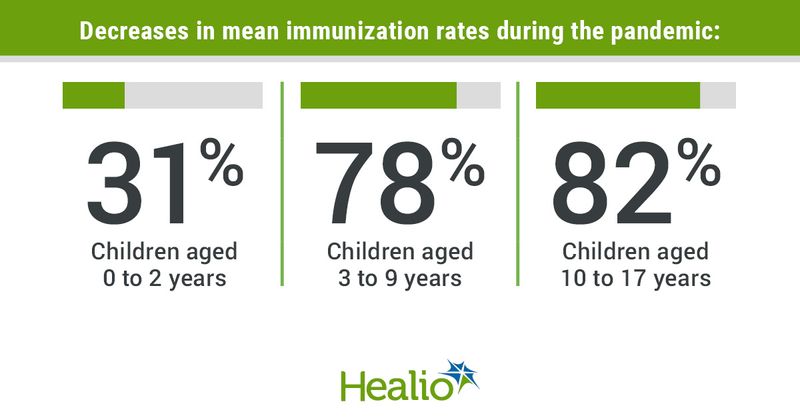Decrease in pediatric vaccinations in Colorado reflects wider problem during pandemic
Data from the Colorado Immunization Information System showed a decrease in vaccination adherence among three separate age groups as a result of the pandemic.
Sean T. O’Leary, MD, MPH, associate professor of pediatric infectious diseases at the University of Colorado’s Denver Anschutz Medical Campus, and colleagues reported on the number of vaccinations that were administered to children aged 0 to 2 years, 3 to 9 years and 10 to 17 years from Jan. 5 — before the COVID-19 pandemic — through May 2.

From Jan. 5 through March 15, the mean number of vaccinations administered per week was 23,523 among 2,181 children aged 0 to 2 years, 6,148 among 1,049 children aged 3 to 9 years, and 8,318 among 933 children aged 10 to 17 years.
On March 15, when social distancing guidelines were put in place, vaccination numbers decreased to 16,146 among 1,648 children aged 0 to 2 years, 1,330 among 408 children aged 3 to 9 years, and 1,529 among 623 children aged 1 to 17 years.
The mean immunization rate dropped by 31% for children aged 0 to 2 years, 78% for children aged 3 to 9 years, and 82% for children aged 10 to 17 years.
In June, WHO reported that at least 80 million children aged younger than 1 year could miss routine vaccinations because of the COVID-19 pandemic. Additionally, a national survey found that two-thirds of U.S. parents were too nervous to take their child to the pediatrician during the pandemic.

“Pediatricians have put in place many strategies to reduce the risk of COVID-19 transmission to their patients and families and for themselves,” O’Leary told Healio. “With these measures in place, there has very little documented COVID-19 transmission within pediatric offices.”
According to the authors, all age groups experienced “a significant drop” in immunizations immediately following the release of the social distance guidance.
The rate of immunizations dropped by 4,581 per week (95% CI, 2,965-6,196) among those aged 0 to 2 years, 2,486 per week (95% CI, 568-4,408) among children aged 3 to 9 years, and 4,060 per week (95% CI, 2,156-5,965) among those aged 10 to 17 years.
“I can’t speak to how people are feeling, but it is very important for parents to make sure their children are up to date on their vaccines,” O’Leary said. “With a dip in vaccination uptake as we have seen here, that makes us prone to outbreaks of vaccine-preventable diseases that are actually significantly more dangerous for children than COVID-19.”
Although before the COVID-19 pandemic there was a trend showing declining numbers of immunizations — dropping 405 vaccinations per week (95% CI, 203-607) — this trend was not as significant as it is now, the authors wrote.
O’Leary told Healio that similar results could be seen nationally. An MMWR report from May showed a “notable decrease” in orders for Vaccines for Children-funded noninfluenza childhood vaccinations from Jan. 6 to April 19, 2020, compared with vaccinations administered from Jan. 7 through April 21, 2019.
“The decline began the week after the national emergency declaration; similar declines in orders for other vaccines were also observed,” the authors wrote. “[Vaccine Safety Datalink] data show a corresponding decline in measles-containing vaccine administrations beginning the week of March 16, 2020.”
References:
O’Leary ST, et al. JAMA Pediatr. 2020;doi:10.1001/jamapediatrics.2020.4733.
Santoli JM, et al. MMWR Morb Mortal Wkly Rep. 2020;doi:10.15585/mmwr.mm691e2.

